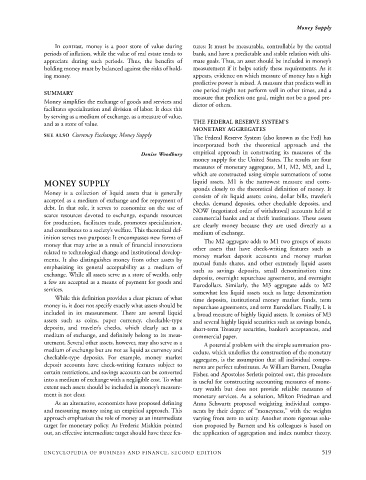Page 542 - Encyclopedia of Business and Finance
P. 542
eobf_M 7/5/06 3:15 PM Page 519
Money Supply
In contrast, money is a poor store of value during tures: It must be measurable, controllable by the central
periods of inflation, while the value of real estate tends to bank, and have a predictable and stable relation with ulti-
appreciate during such periods. Thus, the benefits of mate goals. Thus, an asset should be included in money’s
holding money must by balanced against the risks of hold- measurement if it helps satisfy these requirements. As it
ing money. appears, evidence on which measure of money has a high
predictive power is mixed. A measure that predicts well in
one period might not perform well in other times, and a
SUMMARY
measure that predicts one goal, might not be a good pre-
Money simplifies the exchange of goods and services and
dictor of others.
facilitates specialization and division of labor. It does this
by serving as a medium of exchange, as a measure of value,
and as a store of value. THE FEDERAL RESERVE SYSTEM’S
MONETARY AGGREGATES
SEE ALSO Currency Exchange; Money Supply
The Federal Reserve System (also known as the Fed) has
incorporated both the theoretical approach and the
empirical approach in constructing its measures of the
Denise Woodbury
money supply for the United States. The results are four
measures of monetary aggregates, M1, M2, M3, and L,
which are constructed using simple summations of some
MONEY SUPPLY liquid assets. M1 is the narrowest measure and corre-
sponds closely to the theoretical definition of money. It
Money is a collection of liquid assets that is generally consists of six liquid assets: coins, dollar bills, traveler’s
accepted as a medium of exchange and for repayment of
checks, demand deposits, other checkable deposits, and
debt. In that role, it serves to economize on the use of
NOW (negotiated order of withdrawal) accounts held at
scarce resources devoted to exchange, expands resources
commercial banks and at thrift institutions. These assets
for production, facilitates trade, promotes specialization,
are clearly money because they are used directly as a
and contributes to a society’s welfare. This theoretical def-
medium of exchange.
inition serves two purposes: It encompasses new forms of
The M2 aggregate adds to M1 two groups of assets:
money that may arise as a result of financial innovations
other assets that have check-writing features such as
related to technological change and institutional develop-
money market deposit accounts and money market
ments. It also distinguishes money from other assets by
mutual funds shares, and other extremely liquid assets
emphasizing its general acceptability as a medium of such as savings deposits, small denomination time
exchange. While all assets serve as a store of wealth, only deposits, overnight repurchase agreements, and overnight
a few are accepted as a means of payment for goods and Eurodollars. Similarly, the M3 aggregate adds to M2
services.
somewhat less liquid assets such as large denomination
While this definition provides a clear picture of what time deposits, institutional money market funds, term
money is, it does not specify exactly what assets should be repurchase agreements, and term Eurodollars. Finally, L is
included in its measurement. There are several liquid a broad measure of highly liquid assets. It consists of M3
assets such as coins, paper currency, checkable-type and several highly liquid securities such as savings bonds,
deposits, and traveler’s checks, which clearly act as a short-term Treasury securities, banker’s acceptances, and
medium of exchange, and definitely belong to its meas- commercial paper.
urement. Several other assets, however, may also serve as a
A potential problem with the simple summation pro-
medium of exchange but are not as liquid as currency and cedure, which underlies the construction of the monetary
checkable-type deposits. For example, money market aggregates, is the assumption that all individual compo-
deposit accounts have check-writing features subject to nents are perfect substitutes. As William Barnett, Douglas
certain restrictions, and savings accounts can be converted Fisher, and Apostolos Serletis pointed out, this procedure
into a medium of exchange with a negligible cost. To what is useful for constructing accounting measures of mone-
extent such assets should be included in money’s measure- tary wealth but does not provide reliable measures of
ment is not clear. monetary services. As a solution, Milton Friedman and
As an alternative, economists have proposed defining Anna Schwartz proposed weighting individual compo-
and measuring money using an empirical approach. This nents by their degree of “moneyness,” with the weights
approach emphasizes the role of money as an intermediate varying from zero to unity. Another more rigorous solu-
target for monetary policy. As Frederic Mishkin pointed tion proposed by Barnett and his colleagues is based on
out, an effective intermediate target should have three fea- the application of aggregation and index number theory.
ENCYCLOPEDIA OF BUSINESS AND FINANCE, SECOND EDITION 519

